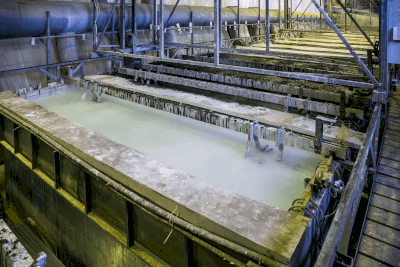What Is Plating

Plating is a process in which a workpiece is immersed in a specified solution to form a thin metal film on the surface of the workpiece.
The types of plated metals began with nickel plating, and today there are many types of metal (zinc, gold, silver, copper, etc.) plating. The plating industry made great progress when electroless nickel plating was invented in the United States after World War II.
Subsequently, plating became possible on ABS resin, a well-known plastic material. As a result, it is now used in various fields, including home appliances and automotive parts.
Types of Plating
1. Nickel Plating
Nickel plating is used as a base plating for stainless steel plating and gold due to its high adhesion to other metals. It can improve corrosion resistance and heat resistance. Generally, electrolytic and electroless plating is used for plating.
2. Chrome Plating
Chrome plating is divided into decorative chrome plating and hard chrome plating according to the thickness of the plating. Decorative chrome plating provides luster and corrosion resistance to the workpiece surface and is often used for automotive parts and home appliances that require a high-end appearance.
3. Rhodium Plating
Rhodium plating is used in various industrial fields such as optical and electronic equipment because it is chemically very stable, has very high hardness, is scratch resistant, has good abrasion resistance, and does not oxidize at temperatures below 500℃.
4. Gold Plating
Gold plating is used for various parts because of its high electrical conductivity and corrosion resistance. Specifically, it is used for electronic circuit boards and connector terminals due to its high electrical conductivity, and for accessories due to its corrosion resistance. Electrolytic plating is the most common plating method.
5. Zinc Plating
Zinc plating is often used to prevent rust on steel products. When the surface of a steel product is scratched, zinc leaches into the scratched area and forms a film called passivation, which has a high rust-preventive effect. Electrolytic plating is used for decorative purposes, while electroless plating is used for corrosion resistance.
Principle of Plating
Plating methods are divided according to whether or not the solution used is electrically conductive.
1. Electroless Plating
Electroless plating is a method of depositing a thin metal film by immersing a workpiece in a plating solution and performing a chemical reaction without an external power supply. Plating is possible even on ceramics and plastics where electricity does not flow, and a uniform metal thin film can be formed. Furthermore, it has the advantage of being able to evenly plate workpieces with complex shapes.
2. Electrolytic Plating
Electrolytic plating is a method of depositing metal on the surface of a workpiece through an electrochemical reaction. A workpiece is placed in an aqueous solution (electrolyte) containing metal ions, and a DC current is passed through the electrolyte as the anode and the immersed workpiece as the cathode. Then, the metal ions in the electrolyte move from the anode to the cathode, and the workpiece surface is plated.
While electrolytic plating can be applied quickly and at a low cost, its disadvantage is that it does not produce a uniform metal film. Furthermore, since it cannot be used on materials that do not conduct electricity, such as ceramics and plastics, the products that can be used are limited.
3. Substitution Plating
Substitution plating is a plating process that utilizes the ionization tendency of metals. In plating, the workpiece is first placed in an aqueous solution containing metal ions. Then, due to the difference in ionization tendency between metals, the metal in the solution replaces the work metal, and the solution metal precipitates on the work surface.
Plating is possible without the use of electrical energy or reducing agents. However, since displacement plating uses the ionization tendency of metals, it cannot be used for products with low ionization tendency or non-metallic products.
Plating Methods
Electroless plating, electrolytic plating, and displacement plating are all plated by a method known as the wet process, in which plating is performed while immersed in an electrolyte solution.